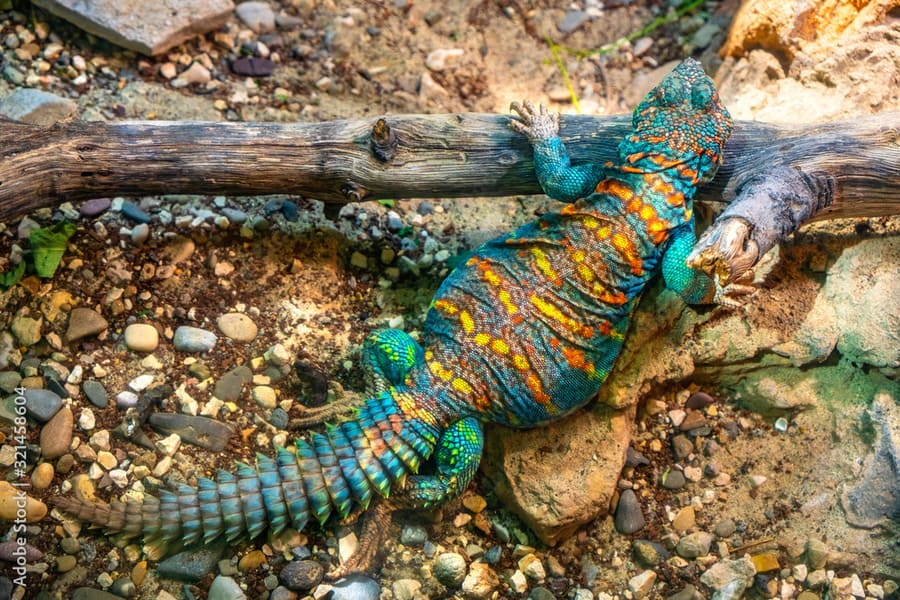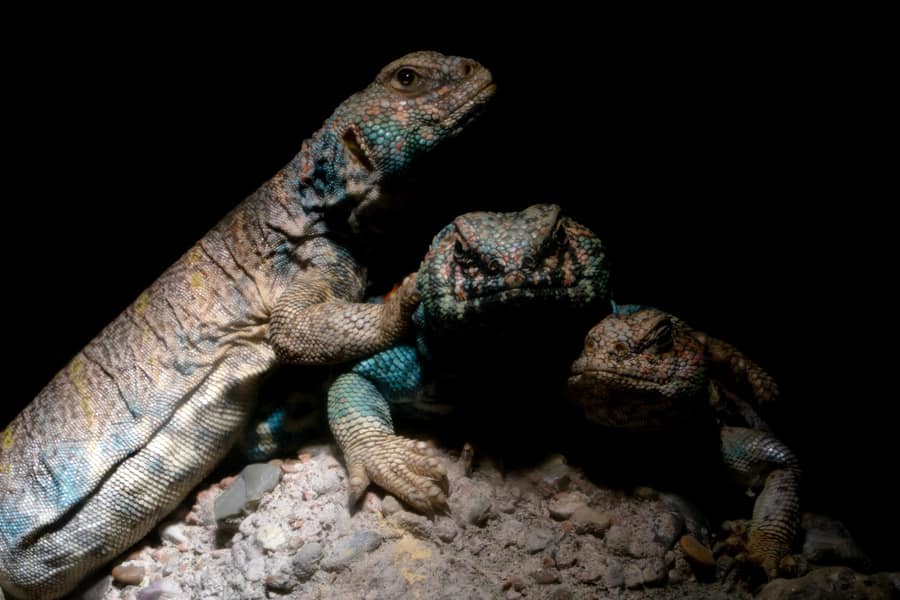Most of the nutritional requirements of Uromastyx lizards can be met with plants, vegetables, beans, nuts, fruits, and seeds. But can Uromastyx lizards eat grass?
Uromastyx lizards are predominantly herbivores eating mostly plants including grass. Grass can be a good addition to a Uromastix lizard’s diet.
This guide will answer your questions on the safety of feeding grass to your Uromastyx lizard, and it will also help you understand what hay and how much is suitable for your Uromastyx lizard. Since Uromastyx lizards are mainly herbivores, you can excuse insects, bugs, or other small animals from their diet.

Do Spiny-Tailed Lizards Naturally Eat Grass
The spiny-tailed lizard, also called Uromastyx, mostly lives in arid regions, bushes, or hilly and rocky areas where vegetation like herbs, shrubs, and grass proliferate. Therefore, they are usually herbivorous, unlike most reptiles.
Spiny-tailed lizards have different teeth from other reptiles that cater to their herbivorous diet. They obtain most of the water they need from food and body fat metabolism.
Due to drought during summer, spiny-tailed lizards feed on spiders, worms, ants, and other small insects to supplement their protein. They are also known to feed on locust nymphs and adults in locust-breeding areas.
However, during wet or colder seasons, spiny-tailed lizards majorly feed on surrounding vegetation and grass. Their teeth are adapted for a plant diet of flowers, beans, fruits and grass.
What Type Of Grass Is Best For Spiny-Tailed Lizards?
There is no existing data on the specific nutritional requirements of spiny-tailed lizards. Still, it is known that a large variety of their food items should be grasses and herbaceous plants. Moreover, since these lizards usually live in harsh habitats, they have evolved to consume a diet high in fiber and relatively low in nutrients.
Spiny-tailed lizards will appreciate a diet of tough and fibrous grasses rich in fiber. You can also feed desert grasses like Bermuda grass and Timothy hay to your pet Uromastyx lizard. In addition, most of the grasses that can be provided to tortoises are also safe for your Uromastyx lizard.
What Type Of Grass Is Worst For Spiny-Tailed Lizards?
Generally, grasses are beneficial for spiny-tailed lizards because of their high-fiber content. However, it is essential to note some grasses with properties that can be bad for spiny-tailed lizards. Examples are grasses growing in acidic soils, like centipede grass or zoysia, and grasses containing high oxalates, like Kikuyu or guinea grass.
Good Food Items For Uromastyx Lizards
Uromastyx lizards require a diet specialized accordingly to their usual habitat of low rainfall and sparse plant life. In the wild, they feed on tough and fibrous desert vegetation, including grasses, cactuses, and flowers, with occasional insects.
Good food items for pet Uromastyx lizards should be a variety of leafy greens supplemented with vegetables. Their diet should include a mix of dark leafy greens and peas, lentils, and seeds.
Greens
Greens are an essential part of an Uromastyx lizard’s diet, especially in mature ones. Greens are an abundant source of cellulose fibers, the most digestible nutrient for Uromastyx lizards. Therefore, a variety of dark, leafy green plants should constitute about 70% of your pet Uromastyx’s diet.
Greens should be fed to Uromastyx lizards several times weekly or daily. Healthy greens must be rich in calcium, low in phosphorus, and low in anti-nutrients like oxalates and goitrogens.
Examples of suitable ones include romaine, endive, escarole, turnip greens, collard greens, mustard greens, dandelion greens, spring salad mixes, cilantro, and radicchio.
Seeds
Seeds are an essential component of an Uromastyx lizard’s diet in the wild. They contain the necessary protein requirements since Uromastyx lizards are majorly herbivores and cannot rely on animal protein.
Seeds like lentils, split peas, birdseed, small beans, sorghum, and millet can serve as crucial protein sources for your pet Uromastyx lizards. Seeds account for about 20% of your Uromastyx’s diet and should be offered multiple times weekly.
Vegetables
Healthy Uromastyx lizards should be fed an ideal amount of vegetables regularly. Vegetables contain various nutrients and comprise about 10% of the Uromastyx lizard’s diet. Good vegetables are mostly bright in color and low in oxalates and phosphorus.
Some of them are prickly pear leaves, acorn squash, corn, parsley, green beans, sweet potato, carrot, butternut squash, bell peppers, and okra. Vegetables should be offered to Uromastyx lizards around four times a week.
In addition, grass hays such as bermudagrass and timothy hay can be added to your Uromastyx lizard’s diet.
Fruits
Fruits should be added to your pet Uromastyx’s diet for enrichment purposes, more than nutritional purposes. Fruits mainly serve as a flavor and moisture enhancer and must be used in moderation.
Fruits such as melons, berries, figs, guava, or kiwis are suitable for occasional treats. Also, flower blossoms like hibiscus flowers, dandelions, or rose petals may be occasionally offered to Uromastyx lizards.
Calcium and other Supplements
Uromastyx lizards, like other reptiles, require higher calcium content than other minerals. Most foods in an Uromastyx’s diet are deficient in calcium and higher in phosphorus. Therefore, calcium supplements with little phosphorus content should be added to the diet. You can thoroughly mix a small amount of calcium supplement powder with the dry food prior or lightly dust it into the food once a week.
Most greens, fruits, and vegetables consumed by Uromastyx lizards are low in magnesium, iron, and iodine. It is essential to ensure any supplement you add to your Uromastyx diet provides these nutrients and ample amounts of vitamins. You can sparingly add a multivitamin or mineral supplement to your Uromastyx diet every 1-2 weeks.

Harmful Food Items For Uromastyx Lizards
Uromastyx lizards are herbivores that dwell in harsh habitats. You should stick to the main Uromastyx diet in the wild and limit heavily domesticated food items when feeding your pet Uromastyx lizard. You should find fresh and healthy food items with the right supplements and avoid the food items described below:
Insects
Insects should only be used as a rare treat or to urge your reluctant Uromastyx to eat better. Although infrequent, Uromastyx lizards consume insects in the wild, so either young or old, your pet Uromastyx might favor insects. However, constantly adding insects to its diet can lead to severe health problems.
Too many animal proteins can cause digestive or severe kidney issues in your Uromastyx lizard. Certain infections and diseases can be obtained from affected insects when Uromastyx lizards consume them.
Uromastyx lizards are usually prone to intestinal blockages, so only small insects can be added to their diet. Therefore, insects should rarely be included in your Uromastyx’s diet. Good insects you can offer are crickets, roaches, hookworms, and soldier fly larvae.
Foods High in Oxalates
Uromastyx lizards should avoid foods high in oxalates or only consume them on rare occasions. Calcium is crucial in maintaining the healthy bones of Uromastyx lizards and preventing complications arising from low calcium content in the body.
However, oxalates bind with the calcium in the body of an Uromastyx and cause them to be excreted as waste products.
Foods that are high in oxalates will prevent your Uromastyx from absorbing calcium, and this can result in calcium deficiency. Calcium deficiency puts your Uromastyx at risk of metabolic bone disease and other severe health problems. Some foods are parsley, spinach, Swiss chard, iceberg lettuce, cabbage, and broccoli.
Similarly, foods that are high in phosphorous can block the absorption of calcium and have the same effect as oxalic foods in Uromastyx lizards—for example, peaches, zucchini, and pomegranates.
Foods High in Goitrogens
Foods that are high in goitrogens should be limited or avoided in your lizard’s diet. Goitrogens interfere with the thyroid gland. They bind with iodine and inhibit the absorption of iodine in the body of lizards. A deficiency of iodine can lead to goiter and complications with the thyroid gland.
The thyroid gland plays an essential role in the smooth functioning of several vital organs and control of metabolism in the body of lizards. Goitrogenic foods can be offered to your Uromastyx once a month. Some goitrogenic foods are Brussels sprouts, beet greens, swede, and kale.
Toxic Foods
While some foods can be offered to Uromastyx lizards in limited amounts, others should be entirely avoided as they are harmful and toxic. Toxic foods can be highly acidic, high in oxalates or phosphorus, or high in goitrogens.
Examples of foods toxic to Uromastyx lizards are potato or tomato leaves, corn, chives, avocado, daffodils, eggplant, juniper, garlic, mushrooms, azalea, castor bean, leeks, buttercup, and rhubarb. You must seek immediate veterinary attention if your pet Uromastyx consumes any of these foods.
Can Grass Make Uromastyx Lizards Sick?
In their natural habitat, Uromastyx lizards feed on tough grass, herbs, and shrubs that are high in fiber. That is, grass is a significant part of their diet in the wild and cannot be harmful to them. Although pet Uromastyx lizards mainly feed on greens, vegetables, and seeds, owners often offer grass as a dry snack or treat.
Occasionally feeding your Uromastyx lizard grass cannot make it sick or harmed. Adding grass hays to Uromastyx lizards’ diet only ensures they have more variety, and there is less chance of nutrients missing in their diet.
How Much Is Grass Okay For These Lizards?
In captivity, grass or hay should be regularly included in the diet of Uromastyx lizards to increase their fiber content. Depending on its availability, feeding grass to your Uromastyx lizard 1-2 times a week, along with other greens and vegetables, is okay.
Better Alternatives To Grass
Although grasses are readily available to Uromastyx lizards in the wild, finding a constant supply of them might be no easy task for pet Uromastyx owners. In addition, domestic grasses are at risk of contamination; grasses with pesticides or similar can be dangerous if eaten. There is also little data available on grasses that are suitable or unsuitable for consumption by Uromastyx lizards.
You can use better alternatives than grass to meet your Uromastyx lizard’s nutritional needs. Some of these are:
- Fresh greens – Greens are an essential part of the Uromastyx lizards’ diet, both in the wild and in captivity. They constitute most of the Uromastyx diet and should be fed to them daily. Collard greens and Swiss chards contain four grams of fiber per cup. Fresh greens have higher fiber content and are a better alternative to grass for Uromastyx lizards.
- Leafy green vegetables – They are loaded with fiber and vitamins and are low in calories. Dark-colored vegetables are rich in fiber content; the darker the color of the vegetable, the higher its fiber content.
- Other food items like lentils, seeds, or pelleted diets are also excellent sources of fiber. They can be supplemented to meet the nutritional requirements of Uromastyx lizards and can be better alternatives to grass.
Is It Okay To Let Uromastyx Lizards Graze In Your Yard?
Since this guide has established that Uromastyx lizards can eat grass, you may be tempted to let them graze in your yard to meet their dietary needs. However, this can go very wrongly. Your grasses or lawn might be sprayed with pesticides or similar chemicals regularly; allowing your Uromastyx lizard to consume this can be detrimental to its health.
Also, the grasses in your yard may be supported by phosphorus fertilizers. Upon consumption, it can lead to an increase in the phosphorus levels in the body of your Uromastyx lizard. High phosphorus levels can inhibit calcium absorption and raise health issues.
Furthermore, the soil in your yard may have low pH, implying a high acidic content. Uromastyx lizards grazing on highly acidic lawns can develop health complications along the line.
Conclusion
The bottom line is that grass is a safe addition to your Uromastyx lizard’s diet. Unlike other reptiles, for an Uromastyx lizard, herbs, shrubs, grasses, and seeds are more nutritional dietary constituents.
The most important thing in their diet is offering these foods in appropriate ratios and frequency to get the correct balance of fiber, vitamins, minerals, and other nutrients.
For a complete breakdown on keeping Uromastyx lizards in pairs, check out this guide.
